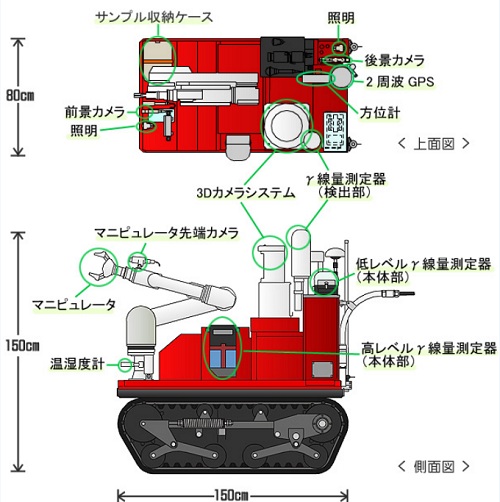The Monirovo is designed to operate at radiation levels that are too high for humans. It is XNUMX meters tall and it moves using a pair of tractor tracks * It has a multi-degree-of-freedom arm whose purpose is to remove obstacles and also to collect samples. The robot has sensors that include a radiation detector, a XNUMXD camera system and temperature and humidity sensors

The team working on the nuclear reactor in Fukushima has now received reinforcements that include robots. The machine, known as Monirovo (that is, robot monitor), went into operation on March 18 - according to The Japanese newspaper Ashai Shimbun.
The Monirovo is designed to operate at radiation levels that are too high for humans. It is five feet tall and moves using a pair of tractor tracks. It appears in two colors to choose from, Monirovo in red and Monirovo in yellow. It has a multi-degree-of-freedom arm that aims to remove obstacles and also collect samples. The robot has sensors that include radiation detectors, a XNUMXD camera system, and temperature and humidity sensors. The robot can be operated from a distance of about a kilometer.
The Monirovo weighs about 600 kilos and is limited to a speed of 2.4 kilometers per hour. It must carry a very thick shield against the radiation, because it has a lot of highly sensitive electronics. Especially the cameras on which Ben is sensitive and vulnerable to the effects of radiation.
The robot was developed by the Japanese Radiation Safety Technology Center in collaboration with the Japanese Ministry of Economy, Trade and Industry. It was opened after a previous accident in Japan with another nuclear reactor in Tokiamura in 1999 in which two workers were killed.
The first machine to be used in the Fukushima reactor is the red Monirobu. Compared to the red machine, the yellow Monirovo has tools to collect dust and sensors to detect flammable gas. This machine will be put into use in the coming days. A number of other robots were developed after the Tokyamura disaster, but were not used for the time being. The Japanese hope that the use of robots will reduce the need for human workers in the danger zone.
In fact, the Japanese used robots even during the earthquake. The Tokyo Fire Department maintains rescue robots known as Robokyo. They lift the victim from the place of danger and take him out of danger. The fire department itself designed the roboquio. The robot is tied to a cable that is 99 meters long and is equipped with infrared cameras and a megaphone. It also has ultrasonic sensors that are able to find victims in places that rescuers cannot reach - such as burning houses. The robot has an oxygen tank for survivors who may need it. The only drawback of the robot is that it cannot drag several victims to it at the same time. But maybe in his improved model it will be possible to do so.
For news on the subject in Popular Science
For news on the subject in New Scientist

5 תגובות
for 1 person. A real and independent robot is called a golem. Have you heard of the poppy cocoon? I hope it's not you.
If I'm not mistaken, the word robot is derived from the Slavic word žavva, which means work.
To: From a person
you, in your reaction (no.1), showing that even in our days, some pupils
, and you are among them, are much more stupid than some primitive robots
good night to you and your clever dog
Am I the only one who thinks this is the worst idea in the world? These Japanese don't read books?
Every time we tried something like this, the robots turned into super creatures with the help of the radioactive radiation. It is true that they may be good, but not sure!!!
Don't let them say later that no one warned.
jelly
Google-Translate sucksssss….
Thanks for the interesting article.
A robot that is remotely controlled by humans is only half a robot to me. A real robot should act in a completely independent and autonomous way and make decisions by itself.